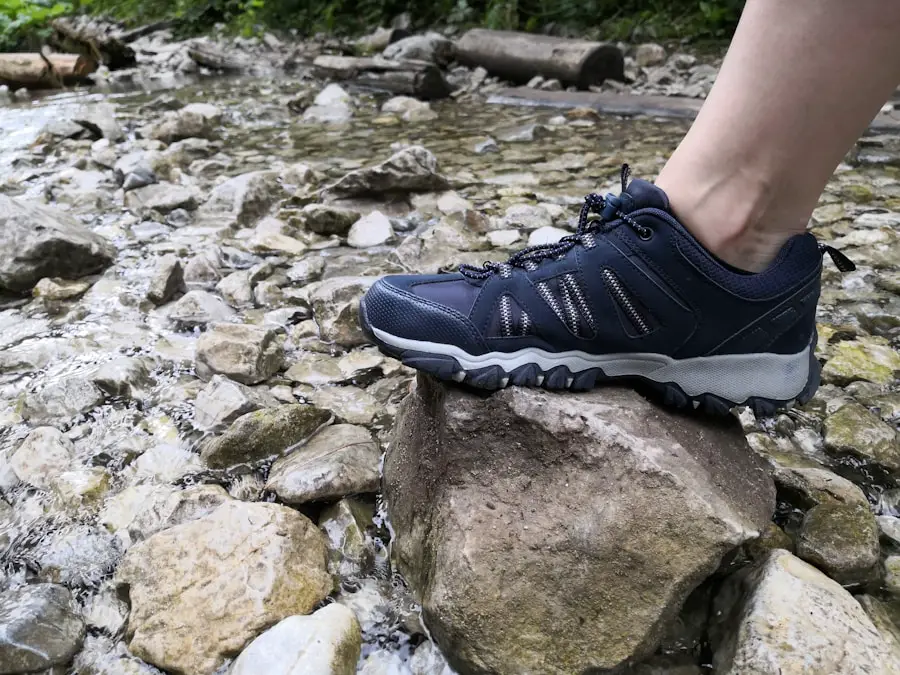The choice of footwear for outdoor activities has long been a topic of discussion among enthusiasts, particularly when it comes to the debate between running shoes and hiking shoes. Each type of footwear is designed with specific purposes in mind, yet many outdoor adventurers find themselves questioning whether running shoes can serve as a viable alternative for hiking. This debate is fueled by the increasing popularity of trail running, where the lines between running and hiking blur, leading to a growing interest in understanding the nuances of each type of shoe.
As more people venture into nature for both exercise and leisure, the need for appropriate footwear becomes paramount, prompting a closer examination of the features, benefits, and potential drawbacks of running shoes in hiking scenarios. The discussion surrounding footwear choices is not merely academic; it has practical implications for comfort, safety, and performance on the trails. While some argue that running shoes offer sufficient support and flexibility for hiking, others contend that the specialized design of hiking shoes provides essential features that enhance stability and protection on rugged terrain.
This article aims to delve into the differences between running and hiking shoes, explore the factors to consider when selecting footwear for hiking, and weigh the potential risks and benefits of using running shoes in this context. By examining these elements, we can better understand how to make informed decisions that align with our outdoor pursuits.
Key Takeaways
- Running shoes and hiking shoes have different designs and features to support different activities and terrains.
- Factors to consider when choosing footwear for hiking include traction, support, and protection.
- Potential risks of using running shoes for hiking include lack of ankle support and insufficient traction on rugged terrain.
- Benefits of using running shoes for hiking include lightweight design and flexibility for easier movement.
- When using running shoes for hiking, consider adding insoles for extra support and traction, and be mindful of the terrain and weather conditions.
Differences Between Running and Hiking Shoes
Design Trade-Offs
Additionally, running shoes tend to have a lower profile, can enhance speed but compromise ankle support on uneven terrain. In contrast, hiking shoes are built to withstand the rigors of varied landscapes, offering features that prioritize stability and protection.
Key Features of Hiking Shoes
The outsoles of hiking shoes are generally more robust, with deeper lugs that provide superior traction on slippery or rocky surfaces. Hiking footwear often incorporates stiffer midsoles to support the foot during lateral movements and uneven ground conditions. Furthermore, many hiking shoes come with reinforced toe caps and water-resistant materials to shield against environmental elements.
Design Distinctions
This distinction in design reflects the different demands placed on footwear during running versus hiking activities.
Factors to Consider When Choosing Footwear for Hiking

When selecting footwear for hiking, several critical factors must be taken into account to ensure a safe and enjoyable experience on the trails. One of the foremost considerations is the terrain you will be traversing. For instance, if your hike involves steep inclines, rocky paths, or muddy conditions, a shoe with excellent grip and ankle support becomes essential.
Hiking shoes are often equipped with features such as high-traction outsoles and supportive structures that help maintain stability on challenging surfaces. Another important factor is the duration and intensity of your hike. Longer hikes may require footwear that offers enhanced cushioning and support to prevent fatigue and discomfort over time.
The fit of the shoe is also crucial; a proper fit can prevent blisters and other foot ailments that can arise from prolonged wear. It is advisable to try on shoes with the socks you plan to wear during your hike and to walk around in them to assess comfort levels before making a purchase. Additionally, considering weather conditions is vital; waterproof or water-resistant options may be necessary for wet environments, while breathable materials are preferable in hot climates.
Potential Risks of Using Running Shoes for Hiking
| Potential Risks | Description |
|---|---|
| Increased risk of ankle injuries | Running shoes lack the ankle support needed for hiking on uneven terrain. |
| Less protection from debris | Hiking shoes provide better protection from rocks, roots, and other trail hazards. |
| Reduced traction | Running shoes may not have the same level of grip as hiking shoes, increasing the risk of slipping. |
| Decreased durability | Hiking shoes are designed to withstand the rigors of hiking, while running shoes may wear out more quickly on the trail. |
| Less water resistance | Hiking shoes are often more water-resistant than running shoes, keeping feet drier in wet conditions. |
While running shoes may seem like a convenient option for hiking due to their lightweight nature and comfort, there are several potential risks associated with their use in rugged outdoor environments. One significant concern is the lack of ankle support that running shoes typically provide. Hiking often involves navigating uneven terrain where ankle twists or sprains can occur easily.
Without the added support from a higher-cut shoe or boot, hikers may be more susceptible to injuries that could derail their outdoor adventures. Another risk lies in the traction capabilities of running shoes. The outsoles of running shoes are designed for smooth surfaces and may not perform well on slippery or rocky trails.
This can lead to slips and falls, particularly in wet conditions or on loose gravel. Additionally, the cushioning in running shoes may not offer adequate protection against sharp rocks or roots that can be encountered on hiking paths. Over time, this lack of protection can lead to discomfort or even injury as the foot endures repeated impacts from uneven ground.
Benefits of Using Running Shoes for Hiking
Despite the potential risks associated with using running shoes for hiking, there are also notable benefits that make them an appealing choice for certain hikers. One of the primary advantages is their lightweight design, which can significantly reduce fatigue during long hikes. For those who prioritize speed or are undertaking shorter hikes on well-maintained trails, running shoes can provide a comfortable and efficient option without the bulkiness of traditional hiking boots.
Moreover, running shoes often feature superior breathability compared to hiking footwear. This can be particularly beneficial in warmer weather conditions where moisture management is crucial for maintaining comfort. The lightweight materials used in many running shoes allow for better airflow around the foot, reducing the likelihood of overheating or excessive sweating during strenuous activities.
Additionally, many runners appreciate the flexibility offered by these shoes, which can enhance natural foot movement and contribute to a more comfortable hiking experience.
Tips for Using Running Shoes for Hiking

If you decide to use running shoes for your next hiking adventure, there are several tips to keep in mind to maximize comfort and safety on the trails. First and foremost, choose a pair of running shoes that fit well and provide adequate cushioning for your specific foot type. Consider using insoles designed for additional arch support if you have flat feet or high arches; this can help improve comfort during long hikes.
It’s also wise to break in your running shoes before embarking on a lengthy hike. Wearing them on shorter walks or runs can help identify any pressure points or discomfort that may arise during extended use. Additionally, pay attention to trail conditions; if you anticipate encountering particularly rugged terrain or adverse weather conditions, it may be prudent to carry a pair of more robust hiking shoes as a backup option.
Alternatives to Running Shoes for Hiking
For those who find that running shoes do not meet their needs while hiking, there are several alternatives worth considering. Trail running shoes represent a hybrid option designed specifically for off-road running but often incorporate features beneficial for hiking as well. These shoes typically offer enhanced traction compared to standard running shoes while maintaining a lightweight profile.
Another alternative is lightweight hiking boots or approach shoes, which provide additional ankle support without sacrificing too much weight. These options often feature stiffer soles for better stability on uneven ground while still being breathable enough for warmer conditions. For those who prefer a minimalist approach, sandals designed for hiking can also be an option; however, they may not provide adequate protection or support for all trail conditions.
Conclusion and Final Recommendations
In navigating the debate between running shoes and hiking footwear, it becomes clear that both options have their merits and drawbacks depending on individual preferences and specific hiking conditions. While running shoes offer lightweight comfort and breathability suitable for certain trails, they may fall short in terms of support and protection on more challenging terrains. Ultimately, understanding your own needs as a hiker—considering factors such as trail conditions, duration of hikes, and personal comfort—will guide you toward making an informed decision about your footwear choice.
For those who frequently hike on well-maintained paths or engage in trail running activities, investing in a quality pair of trail running shoes may provide an excellent balance between performance and comfort. Conversely, if your adventures take you into more rugged landscapes or longer excursions, opting for dedicated hiking footwear will likely enhance your overall experience while minimizing risks associated with inadequate support or traction. Regardless of your choice, ensuring proper fit and breaking in your footwear will contribute significantly to enjoying your time spent exploring the great outdoors.
If you are considering using running shoes for hiking, you may also be interested in reading about the best waterproof sneakers for travel. These sneakers are designed to withstand various weather conditions and terrains, making them a versatile option for outdoor activities. Check out the article here for more information on how to choose the right footwear for your next adventure.
Love travel? Join Our Facebook Community For More Tips.
FAQs
What are the differences between running shoes and hiking shoes?
Running shoes are designed for forward motion and cushioning, while hiking shoes are designed for stability, support, and protection on uneven terrain. Hiking shoes also typically have a more aggressive tread pattern for better traction on trails.
Can running shoes be used for hiking?
While running shoes can be used for light hiking on well-maintained trails, they may not provide the same level of support and protection as hiking shoes. It’s important to consider the terrain and duration of the hike when deciding whether to use running shoes for hiking.
What are the potential drawbacks of using running shoes for hiking?
Running shoes may not provide enough ankle support and protection for hiking on rugged or uneven terrain. They also may not have the same level of durability as hiking shoes, which could lead to quicker wear and tear on longer hikes.
Are there any benefits to using running shoes for hiking?
Running shoes are typically lighter and more flexible than hiking shoes, which can be beneficial for shorter, less technical hikes. They may also provide more cushioning and comfort for some hikers.
What should I consider when deciding between running shoes and hiking shoes for a hike?
Consider the terrain, duration, and intensity of the hike. For longer or more challenging hikes, it’s generally recommended to use hiking shoes for better support and protection. For shorter, less technical hikes, running shoes may be suitable.
